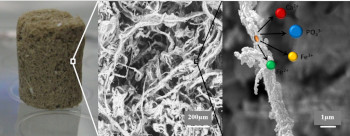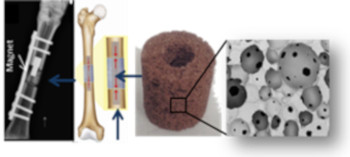This website uses cookies so that we can provide you with the best user experience possible. Cookie information is stored in your browser and performs functions such as recognising you when you return to our website and helping our team to understand which sections of the website you find most interesting and useful. More information in our Privacy Policy
Ceramics and Hybrid Magnetic Implants
Porous ceramic and hybrid scaffolds with superparamagnetic properties
Principal investigators: Simone Sprio, Monica Sandri, Michele Iafisco, Anna Tampieri
Personnel involved: Massimiliano Dapporto, Alessio Adamiano, Silvia Panseri, Monica Montesi, Elisabetta Campodoni, Marta Tavoni
Magnetic bone scaffolds are today considered as promising drivers of bone regeneration, thanks to their ability to deliver magnetic signals to cells and stimulate regeneration process.
In order to exhibit close compositional mimicry with natural bone and permit physiological stimulation of osteogenic and angiogenic processes, bioactive bone scaffolds are endowed with magnetic properties by incorporation or doping with iron ions. Bioactive ceramic composition based on calcium phosphate such as hydroxyapatite or tricalcium phosphate are associated with superparamagnetic iron oxides to obtain bioactive composites. Such mixtures are processed by various forming technologies such as replica, foaming, freeze casting, to obtain porous bodies that are then subjected to thermal consolidation. The sintering process is carried out under reducing atmosphere to prevent oxidation of iron ions and reduction of superparamagnetic properties. The ceramic scaffold can find application as substitutes of critical size defects in orthopedics.
To obtain scaffolds with enhanced mimicry of bone tissue, hybrid magnetic porous scaffolds are developed by biomineralization process enabling the self-assembly of natural polymer blends, particularly based on type I collagen, and simultaneous mineralization with divalent and trivalent iron ions in amounts controlled to obtain ionic substitutions in the calcium sites of the apatite lattice and generate iron-doped hydroxyapatite with intrinsic magnetic properties. The scaffolds are obtained by directed freeze drying and stabilized by chemical cross-linking. The close mimicry of the composition and structure of woven bone yields ability to direct the cell fate towards osteoblastic behavior. The stabilization of the scaffold by cross-linking permits controlled bio-resorption and regeneration of bone defects. Hybrid magnetic scaffolds can be applied as regenerative bone substitutes in orthopedics, spinal surgery and dentistry. They can be also developed as multifunctional scaffolds mimicking complex anatomical regions as joints or periodontium with compositional and magnetic gradients to provide magnetic forces stimulating bone regeneration.
The long-lasting collaborations with companies active in the biomedical field is a strong driver for the development of new biomaterials and devices for solving clinical needs of relevant socio-economic impact. In particular, the collaboration with Finceramica S.p.A., as partner of many EU-funded research and national projects (e.g.: AUTOBONE, MAGISTER, Ageing) led to the development of one international patent protecting iron-doped superparamagnetic apatites and scaffolds.
Equipment and processes
- Freeze drier
- Furnaces for debonding
- Furnaces operating in reducing atmosphere
Technologies used to develop large 3-D magnetic scaffolds
- Chemical synthesis
- Powder processing
- Replica by sacrificial templates
- Direct foaming
- Freeze casting
- Sintering processes
Technologies used to develop biomimetic hybrid scaffolds
- Biomineralization
- Freeze drying
- Cross-linking


Main collaborations
- Istituti Ortopedici Rizzoli (Italia)
- Università di Santiago de Compostela (Spagna)
- Università Friedrich Schiller di Jena (Germania)
- Finceramica S.p.A. (Italia).
Projects
Publications & Patents
- Sprio S., Campodoni E., Sandri M., Preti L., Keppler T., Müller F. A., Pugno N. M., Tampieri A. A Graded Multifunctional Hybrid Scaffold with Superparamagnetic Ability for Periodontal Regeneration. International Journal of Molecular Sciences 19 (2018) 3604 IF 3.687
- Sprio S., Panseri S., Adamiano A., Sandri M., Uhlarz M., Herrmannsdorfer T., Landi E., Pineiro-Remondo Y., Tampieri A. Porous hydroxyapatite-magnetite composites as carriers for guided bone regeneration. Frontiers in Nanoscience and Nanotechnology. 3(1) (2017) 1-9 doi: 10.15761/FNN.1000145, ISSN: 2397-6527 IF: 1.2
- Patricio T., Panseri S., Sandri M., Tampieri A., Sprio S. New bioactive bone-like microspheres with intrinsic magnetic properties obtained by bio-inspired mineralisation process. Material Science and Engineering C 77 (2017) 613–623 IF: 3.2
- Russo A., Bianchi M., Sartori M., Parilli A., Panseri S., Ortolani A., Sandri M., Boi M., Salter D., Maltarello M.C., Giavaresi G., Fini M., Dediu V., Tampieri A., Marcacci M. Magnetic forces and magnetized biomaterials provide dynamic flux information during bone regeneration Journal of Materials Science: Materials in Medicine, (2016) 27:51. DOI 10.1007/s10856-015-5659-0. IF: 2.27
- De Santis R., Russo A., Gloria A., D’Amora U., Russo T., Panseri S., Sandri M., Tampieri A., Marcacci M., Dediu V.A., Wilde C.J., Ambrosio L. Towards the design of 3D fiber-deposited poly(e-caprolactone)/iron-doped hydroxyapatite nanocomposite magnetic scaffolds for bone regeneration. Journal of Biomedical Nanotechnology 11(7) (2015) 1236-1246 IF: 7.6
- Tampieri A., Iafisco M., Sandri M., Panseri S., Cunha C., Sprio S., Savini E., Uhlarz M., Herrmannsdörfer T. Magnetic bio‐inspired hybrid nanostructured collagen‐hydroxyapatite scaffolds supporting cell proliferation and tuning regenerative process. ASC Applied Materials & Interfaces 6 (2014) 15697-15707. IF: 7.145
- Panseri S., Russo A., Sartori M., Giavaresi G., Sandri M, Fini M., Maltarello M.C., Shelyakova T., Ortolani A., Visani A., Dediu A., Tampieri A., Marcacci M. Modifying bone scaffold architecture in vivo with permanent magnets to facilitate fixation of magnetic scaffolds. Bone 56, (2013) 432-439 http://dx.doi.org/10.1016/j.bone.2013.07.015. IF: 3.823
